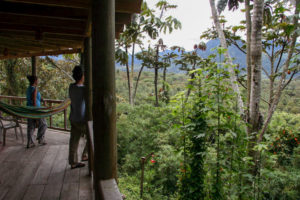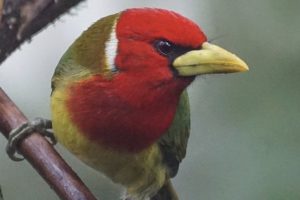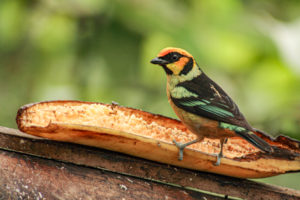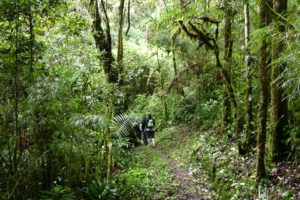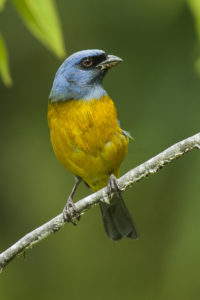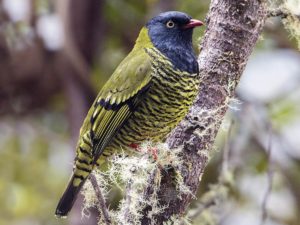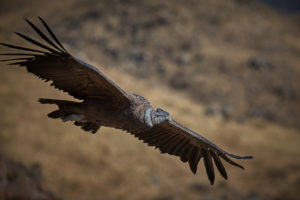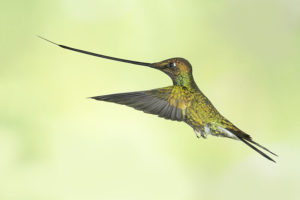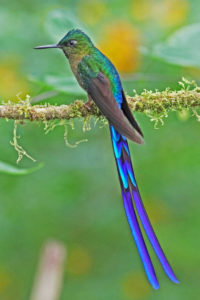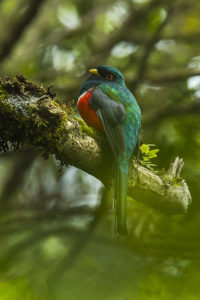Amazing Ecuador
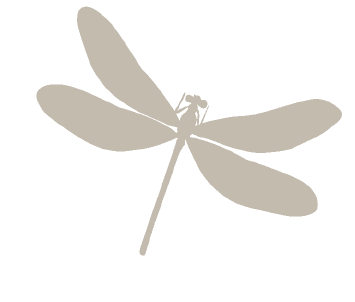
Birding the Northern Andes
January 26 - February 8 2023
$4,350 | single supplement: $445
($500 deposit due upon registration)
12 participants max
B
ird with us in the Ecuadorian Andes, a region known to be Earth’s undisputed champion of biodiversity!
We’ll explore both the eastern and western slopes of the northern Andes, starting at Antisana Ecological Reserve and Papallacta Pass along the continental divide. Home to the Andean Condor and Spectacled Bear, these high-elevation paramo reserves will be the gateway of our first first week of birding. Then, over the next several days, we'll plunge 12,000 vertical feet through the temperate, subtropical and foothill zones.
We will first base ourselves at Guango Lodge and San Isidro Cloud Forest Lodge, surrounded by private cloud forest reserves. Lower in elevation, the most diverse region of our trip awaits in the heart of Ecuador’s eastern foothills, where we will have the better part of three days to sample the diverse avifauna based out of the acclaimed Wildsumaco Lodge. This area is home to 621 bird species (and counting), as well as a tamarin monkeys, sloths, kinkajous and a dazzling array of butterflies.
We end our trip on the western slopes of the Andes, birding in the highlands on the west slope in pristine temperate forest, birding cloud forests at key spots in the Mindo area. On our last day in Ecuador, we’ll visit the famous Reserva Paz de las Aves, where an active Andean Cock-of-the-Rock lek awaits, along with rarely-seen antpittas and other secretive forest understory birds.
Additional Information
Flow of the Day: The itinerary is designed to maximize our experience with Ecuador's great diversity of birdlife and ecosystems. We won’t, however, be rushing from place to place to chase the largest species list possible. Our goal is to spend time appreciating the species we encounter at an enjoyable pace. Birding walks begin in the early morning, and we travel slowly to allow for the best bird and wildlife encounters and observation.
We visit several private reserves, gardens, and feeders where it is easier to find many of our target species. Afternoon plans typically allow for some afternoon rest time at the lodges, though this is not always feasible when we are transferring between lodges and landscapes.
Clothing: Pack light field clothing of neutral colors. Bring several pairs of long pants and comfortable, light, airy shirts. Long-sleeved (relaxed fit) shirts are useful for protection from the sun, as is a light hat or cap. Good rain gear is essential, and a small umbrella is also recommended. Be sure to have a pair of comfortable walking shoes or hiking boots, plus a second pair of tennis shoes or sandals. A sweater or fleece is important for our higher elevation areas. You may want more casual clothing for traveling or dinners. A small washcloth and handkerchiefs will be helpful.
Equipment: Bring a pair of binoculars, a field guide and a camera with extra batteries. The guides will carry spotting scopes. Pack sunglasses and sunscreen, a small flashlight or headlamp, a small alarm clock (a smartphone will work), insect repellent, a small daypack, and a small folding stool if you get tired standing for long periods waiting for birds.
Health Considerations: Please consult your physician before the trip for any recommended immunizations. Mosquitoes and other small, biting insects can sometimes be a nuisance, especially in the forested areas. Chiggers are found in the grassy areas. We suggest a stick-type repellent for your face and hands, plus at least one pump-style container of repellent for your clothing.
Physical Expectations: Much of the birding on this trip will be along roadsides or easily walked trails, but do expect some mud and soggy conditions, but nothing extreme. There is some birding at higher altitudes, which might require some folks to walk more slowly on hillier slopes.
Participants should be able to hike on moderate terrain up to 2 miles per day, and be ready to expect conditions that may be hot, cold, dry, wet, or anything in-between.
Transportation: In-country transportation is in a comfortable minibus with A/C.
Accommodations: All of the lodges where we’ll be staying are situated in or near ecological reserves. All lodges are clean and comfortable with running water and electricity.
Chip Darmstadt is the "emeritus" executive director of North Branch Nature Center and an avid neotropical birder and naturalist. Chip has led birding trips in the US and across the world with NBNC for the last two decades, observing over 2,000 bird species along the way. Chip's first experience in the tropics was as a field assistant studying birds in Venezuela and Costa Rica. After catching the tropical birding bug, he has returned to the tropics many times to marvel at the incredible diversity of Central and South America. When not occupied with his varied NBNC duties, Chip works on extending his streak of over 1,400 consecutive days of eBird checklists!
We will also have an expert, bilingual in-country guide for the entire trip.
What’s included:
- All lodging and meals, expect meals in Quito and at airports.
- Two expert naturalist guides, including a local guide intimately familiar with the region.
- Any entrance fees and park admissions.
- Transportation in a small, comfortable bus, including transfer to and from the airport.
- Pre-departure orientation session virtually or at North Branch Nature Center before the trip.
What is not included: Airfare, gratuities, some meals and incidentals are not included.
Ready to go to Ecuador?
Email [email protected] to get signed up.
For a list of species seen on a previous tours of a similar itinerary, Click Here.
Itinerary
(Itinerary subject to change based on weather, recent sightings, and guide and participant preferences)
Day 1: International arrival and transfer to hotel near Quito. Night San Jose de Puembo Garden Hotel.
Day 2:
Today we have a variety of habitats that we will want to explore. We will start right at the hotel to bird the gardens that attract a healthy variety of the avifauna found in the drier valleys of the Quito area. After this it will be straight up to the beautiful Antisana reserve for the rest of the morning where we will have our first look at and explore the high paramos of the continental divide. We will visit a set of hummingbird feeders here too that can be excellent for Giant and Sword-billed Hummingbirds. After this we will make our way back around to the main road to Papallacta and Guango, through the central valley and a mix of agricultural zones and chaparral forests, before leaving the city behind and (once again) rising up steeply to the high and (often) windswept paramos of the Papallacta Pass. Among the many bird possibilities today that we will be particularly on the lookout for include Andean Condor, Carunculated Caracara, Andean Gull, Black-faced Ibis, Black-tailed Trainbearer, Scrub & Blue-and-yellow Tanagers and Southern Yellow-Grosbeak, Rufous-bellied Seedsnipe, Ecuadorian Hillstar, Tawny Antpitta, Many-striped Canastero, White-chinned Thistletail, Red-rumped Bush-Tyrant, Black-billed Shrike-Tyrant, Brown-backed Chat-Tyrant, some interesting seedeaters, and even Giant Conebill, with a bit of luck.. If there were a day to have your camera ready, this would be it – on clear days the scenery is spectacular, with superb views of the snow-capped Volcán Antisana, and endless high Andean mountain scenes harboring a backdrop of textures that make for an unforgettable birding setting.
In the late afternoon, we will work our way down the east-slope – Amazonian drainage now – towards Guango Lodge. On the way we will pass through some beautiful high-elevation temperate forests where we may have time to stop and soak in this birdy zone; some of the possibilities include Black-chested Buzzard-Eagle, Viridian Metaltail, Buff-breasted Mountain-Tanager, just to name a very few. If we get to Guango Lodge in time we will have our first crack at the hummingbird feeders that will be dripping with species such as Tourmaline Sunangel, Sword-billed Hummingbird and White-bellied Woodstar. Our box lunch in the field will allow us to remain flexible with respect to how we plan our birding for the day. Night Guango Lodge.
Day 3: This day will be devoted to birding the trails and spectacular hummingbird feeders at Guango Lodge. On the grounds here we frequently run into some of the best temperate forest flocks on any of our tours in Ecuador; in a matter of minutes it isn’t uncommon to see White-banded Tyrannulet, Black-capped and Black-eared Hemispingus, Slaty and Pale-naped Brush-Finch, Gray-hooded Bush-Tanager and even Plushcap. With some luck we could even run into Andean Guan, Gray-breasted Mountain-Toucan, Dusky Piha, or even Red-hooded Tanager. We will enjoy a hot, sit-down lunch, only feet away from the hummingbird feeders (!) and in the afternoon we will either bird another trail or enjoy the hummingbird feeders. Depending on how we did the previous day in the paramo highlands yesterday around the Papallacta Pass, we will probably want to have another go at this elevational zone as well since it is within easy striking distance from Guango and impossible to cover in only one afternoon. Night Guango Lodge.
Day 4: After some more birding at Guango and another healthy sit at the hummer feeders – and another delicious Guango lunch - we will leave towards San Isidro, making birding stops along the way. We will get to the lodge with time to check into our rooms and get settled in before dinner. Assuming the weather cooperates, we will probably want to try a short night walk – right between the cabins and the dining room - in search of the “mystery owl”. This is a gorgeous owl that may one day prove to be a new species to science. Night at San Isidro Cloud Forest Lodge.
Day 5 & 6: We will have two full days to explore the subtropical cloud forests around San Isidro and its surroundings. We plan to start the first morning with some birding right around the lodge, where we often find it hard to pull ourselves away… the birds just sometimes keep coming. Some of the regulars include Montane and Olive-backed Woodcreepers, Golden-crowned Flycatcher, Black-billed Peppershrike, Inca Jay and Subtropical Cacique! After about an hour of this, we will want to visit the White-bellied and Chestnut-crowned Antpitta feeders, where you will likely see these shy understory species only feet away. A quick sit at the bird blind can be good for Oleaginous Hemispingus, Three-striped Warbler, Gray-breasted Wood-Wren, and even some other surprises. The rest of the morning will be spent birding the ample trail system and forested roadside at Cabañas San Isidro where quetzals and mixed flocks are often found. After a hot, sit-down lunch at the lodge (and possibly an afternoon break), we will continue birding the property along one of the forest trails or even a nearby roadside. The hummingbird feeders right at the dining room porch are always active, with the likes of Long-tailed Sylph, Chestnut-breasted and Buff-tailed Coronets, Fawn-breasted Brilliant, Bronzy Inca, and sometimes Gorgeted Woodstar.
The following day might find us birding a nearby roadside (or trail) in search of species not found right around the lodge, such as Black-billed Mountain-Toucan, Flammulated Treehunter, Grass-green Tanager, and many others. Nights at San Isidro Cloud Forest Lodge.
Day 7: We will get up early and head downs-slope to the Loreto Road where we will spend the morning birding this scenic zone on the way to WildSumaco. In these eastern foothill areas the birding possibilities really explode, with all new sets of tanagers, antbirds, and others. Considering that this is one of the most biologically diverse spots on the planet we will want to spend a full day exploring these rich forested hills. Assuming weather cooperates, we will have a long list of potential species, including Coppery-chested Jacamar, Golden-eared and Orange-eared Tanagers, and Golden-collared Honeycreeper. We might even luck into a fruiteater or two! Night WildSumaco Lodge.
Days 8 & 9: With two full days to bird the foothills out of Wildsumaco, the possibilities will seem almost endless. Strolling the roadsides will certainly produce some diverse and active mixed tanager and insectivorous flocks, while the trails can be an interesting option for harder to find species. The hummingbird feeders around the lodge never disappoint, with Golden-tailed Sapphire, Fork-tailed Woodnymph, Wire-crested Thorntail, and many other dazzling species, and the birding blind attracts an interesting set of understory species like Peruvian Warbling-Antbird, White-chested Puffbird, and White-backed Fire-Eye. Some of the special birds of the zone that we will be keeping an eye out for include: Yellow-throated Toucan, Chestnut-fronted Macaw, Chestnut-crowned Gnateater, Short-tailed Antthrush, Gray-tailed Piha, Blue-rumped and White-crowned Manakins, Rufous-naped Greenlet, and Blue-browed and Golden-eared Tanagers.
Day 10: Birding drive to Mindo area along the old Nono Mindo Road. After a packed lunch up at the reserve we will work our way down-slope, along the upper stretches of the old Nono-Mindo Rd., towards the small village of Tandayapa, passing through some gorgeous roadside, subtropical forest where we will hope for our first looks at Toucan Barbet, Golden-headed Quetzal, Andean Cock-of-the-Rock, or even Beautiful Jay. We hope get to the lodge in time for a first go at the active hummingbird feeders, if not, we shall have plenty of time here during our stay to enjoy them. Night Septimo Paraiso Lodge.
Day 11: All day birding Septimo Paraiso and its surroundings with a visit to nearby feeding stations in the afternoon. We can play it by ear this day with a mix of trail and roadside birding, and just go where the birds lead us. Some of the bird targets include Wattled Guan, Black-and-chestnut Eagle, Crimson-rumped Toucanet, Crested Quetzal, Scaled Fruiteater, and multiple tanager species. Some of the mid-elevation hummer species that we are likely to see include Violet-tailed Sylph, Velvet-purple Cornet, Booted Racket-tail, Purple-bibbed Whitetip, and Brown Violetear, among many others. Evening might find us looking for a night bird our two, such as Mottled Owl and Rufescent Screech-Owl right around the lodge, or even Lyre-tailed Nightjar slightly further afield. Night Septimo Paraiso Lodge.
Day 12: We will rise early today in order to get to the Mashpi area. This zone is a fascinating area of very wet cloud forest, and with a particular set of birds hard to find – and close to their southern-most ranges - in other places. We will pay particular attention to the Amaguza feeders that attract an impressive array of tanagers and other species; the Moss-backed and Rufous-throated Tanagers would be real highlights! With a packed lunch in tow, we are free to orchestrate our activities according to the weather, but we will probably spend ample time birding the roadsides, that can be very birdy. Other special birds that we will be keeping an eye out for include Buffy Tuftedcheek, Orange-breasted Fruiteater, Black Solitaire, Glistening-green Tanager, Indigo Flowerpiercer, and if we are very lucky, Choco Vireo. Night Septimo Paraiso Lodge.
Day 13: All morning visit to Paz de Las Aves reserve. We will want to leave the lodge early to get to Paz de Las Aves in time for a look at the active Andean Cock-of-the-Rock there. After some time with these marvelous birds, we will branch out and follow Angel Paz's lead as he guides through the trails on his property for what we hope will be some very close encounters with some antpittas – think Giant, Moustached, and Yellow-breasted - and other hard to find understory species under normal birding conditions. In the afternoon we will bird our way back to Quito, with stops along the way to look for any missed birds. Night San Jose de Puembo Garden Hotel.
Day 14: International flights home.
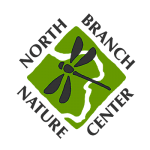
713 Elm Street
Montpelier, Vermont 05602
(802) 229-6206
Hours: Center Open Monday-Friday 9-4
Trails Open 24/7

